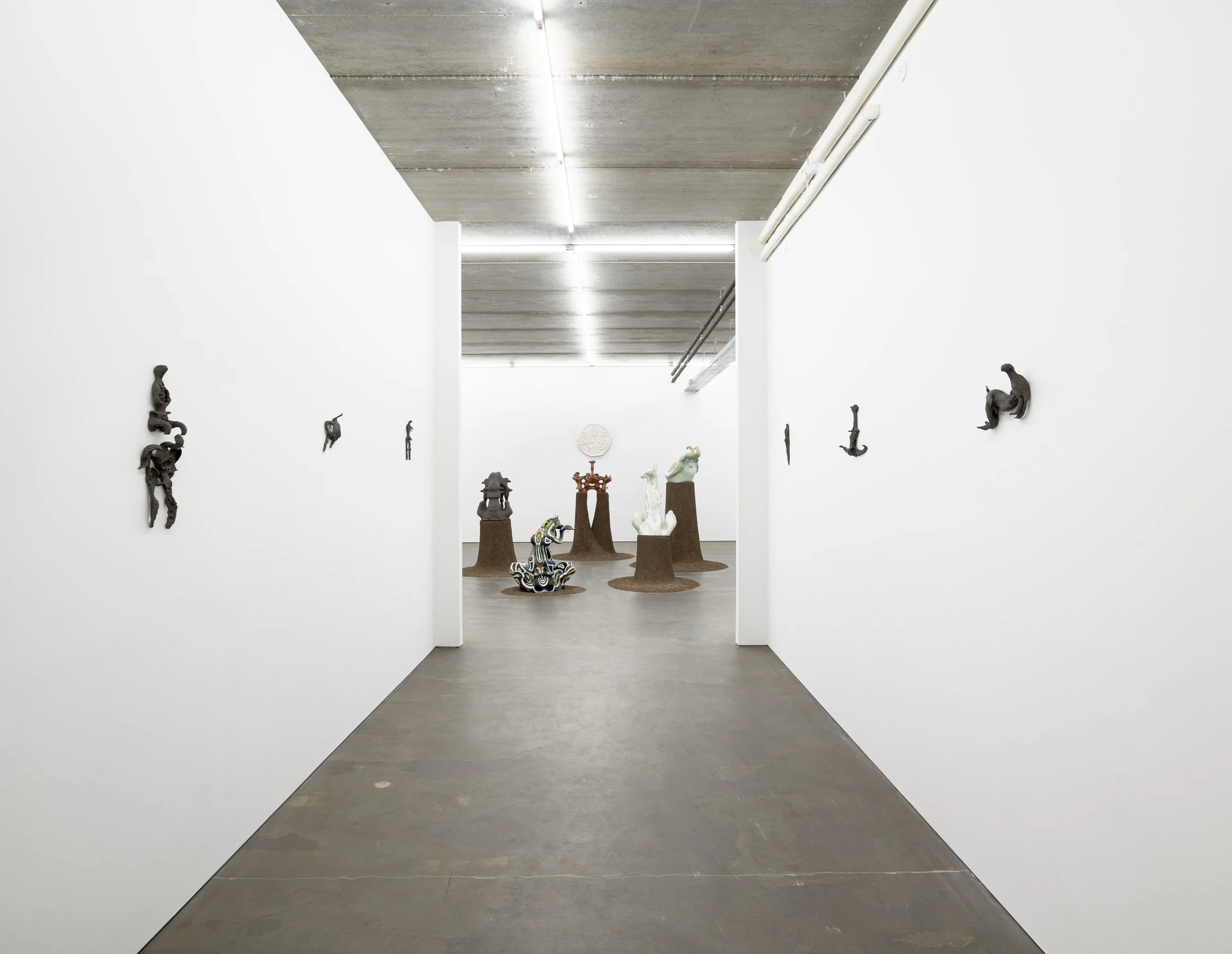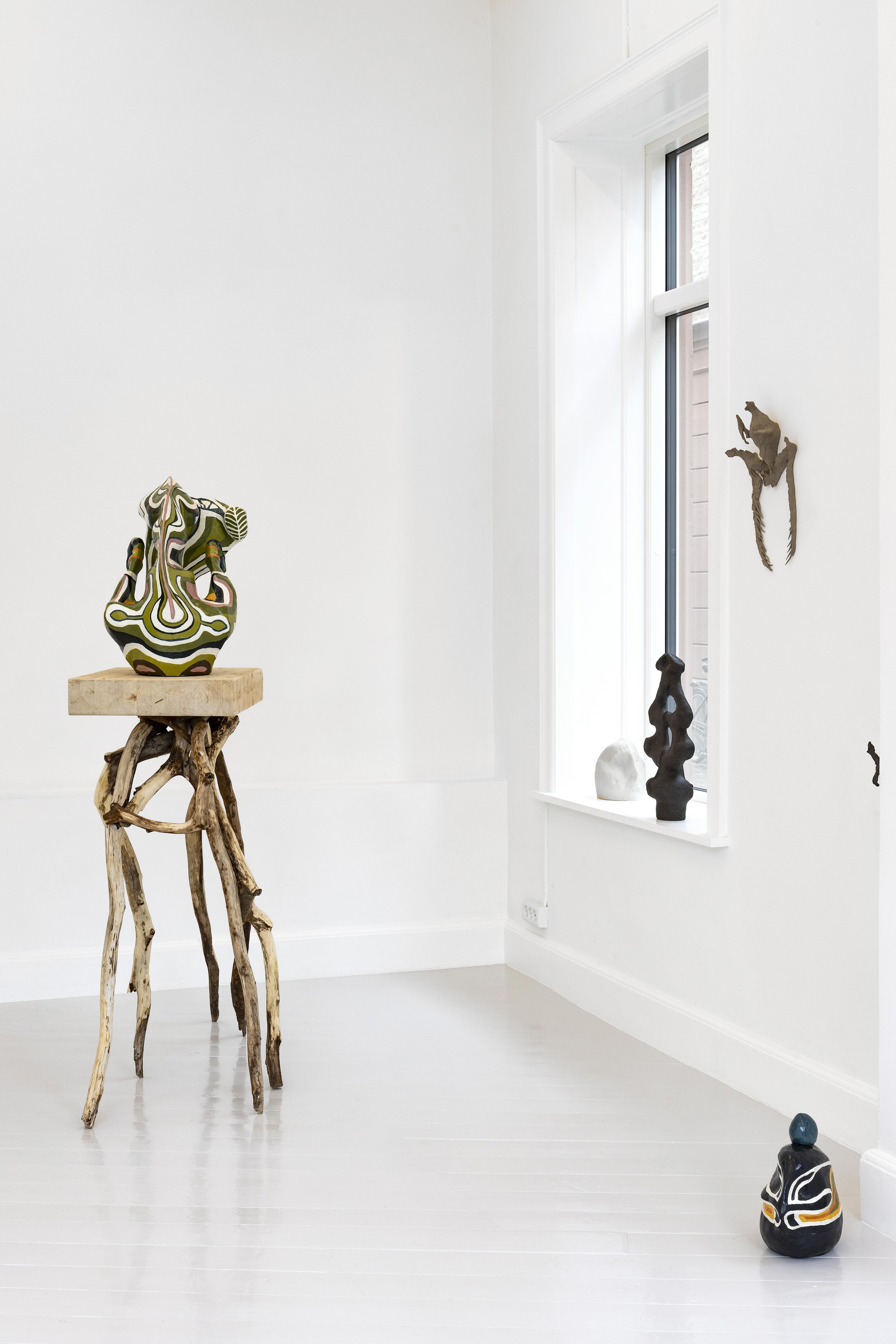Timekeeping and Shapeshifting in Clay: In Conversation with Jasmin Franko
In the garden outside Rønnebæksholm Kunsthal in Denmark, a square is dug out of the green grass, exposing the earth beneath. The area is closed off with a low-hanging rope, like those found at archeological digging sites. Inside the square, four ceramic sculptures lay, partly visible in the ground. The site challenges our understanding of time and human interference with it—the sculptures can resemble found artifacts on their way of being dug out, as well as items recently placed there for nature to reclaim or for someone in the distant future to uncover. And while the shapes look familiar, they also possess something more-than-human or even alien.
In the hands of Iraqi-Hungarian, Danish-born artist Jasmin Franko, clay becomes a site for transformation and speculative world-building. Chronological time becomes distorted, and fixed understandings of history, the body, and technology are questioned. Drawing on science fiction and Afro-futurism’s critical fabulation as tools, her works invite the observer to defamiliarize with the present and to consider alternative cosmologies and temporalities.
Marthe Yung Mee Hansen: How did you start working with art, and what led you to focus on clay and ceramics in your practice?
Jasmin Franko: I grew up in a house where my mother was always painting and drawing. She handed down to me the ability to express myself in images and build worlds. Later on, I found that by moving from flat surfaces to sculptural work, I could give form to internal dialogues that I felt needed a body of some sort to obstruct the space. It became a way for me to measure myself physically in shapes that could hold complex questions around belonging and being in the world.
As for getting into ceramics, I was traveling in Northern India for a while, quite broke, after years of moving around. As I moved through the Himalayas, I got to know of the local clay and ceramic practice in the Chamba Valley. While I was still on this trip, I applied for and got accepted into the ceramics program at The Royal Danish Academy, located on the island of Bornholm.
Clay is incredibly generous, and I love that. It fits my temperament to work with a material that, in return for its abundance, demands a high level of caretaking and attention. In a way, the challenges of working with an alive material, is exactly what keep me dedicated. It has an immediate reaction and is responsive. Because of its innate qualities of animism, working with clay provokes intuitive methods, where subconscious questions get a lot of space to expand. It is instinctive for me to make work that feels as if it has created itself, and therefore my work often takes the shape of beings, bodies, or devices that have some kind of hidden ability.
MYMH: Memory has been a key theme in your work for a long time. Can you talk more about this?
JF: Yes, memory keeps on being a theme. It is not really memory as specific events that have occurred, but rather a search for ephemeral atmospheres and forms that evoke feelings of remembering. Forms that seem recognizable yet ambivalent, much like dream logics, can feel fleeting and intimately close at the same time. Because I work so closely in dialogue with the material, my practice has taken on the characteristics and qualities of clay in so many ways.
I understand clay as a timekeeping material, so it naturally becomes a medium for both preserving and distorting time. Sculptural work, as a physical manifestation of memories and contemplation, evokes a certain kind of urgency by interfering with our spaces and insisting on an interaction with form in an intimate and bodily way.
MYMH: The passing of time also becomes evident in some of your works that refer to relics or fossils. Do you have an interest in archeology?
JF: Absolutely. In an odd way, it moves me deeply every time I visit an archeological site. I suppose I am touched by the affirmation of the distant past as real and tangible. Another part is the speculative aspects. Archeology in itself is kind of a wild practice of speculative fiction, a way to make assemblage and collage out of residue.
I am currently part of an exhibition at Rønnebæksholm Kunsthal in Denmark, where I made an excavation site in the park outside. The work, called Gene pool, contains four large ceramic sculptures that are dug into the ground, but still visible. I wanted to create a site that could say something about reversed archeology, where the line between found and created objects is blurred and where the feeling of chronological time is distorted. I aimed to make a work where I, as an artist, have almost completely stepped out of the frame, where it felt as if it already existed long before me. Gene pool questions what excavation is or can be, and tries to flip it.
MYMH: In your practice, you also draw inspiration from science fiction and Afro-futurism. How do these genres influence your work?
JF: I am drawn to science fiction and Afro-futurism as critical tools. As such, they enable me to materialize metaphors and defamiliarize myself with the present, to see our absurdity with new eyes. When images, whatever the medium, touch upon the weirdness and eeriness of what life is, it produces a genuine curiosity within me. The unknown, or whatever lies just out of our immediate reach, is something I try to stretch myself to explore.
In terms of Afro-futurism, I find critical fabulation a specifically powerful tool. The idea of surgically opening up time to disrupt established historical accounts, for then to reassess and rewrite the archive, is incredibly inspirational. In these genres, time-travelling hovers as a recurring theme, and this is something that has influenced me heavily. I often contemplate how to create work that has an anachronistic nature, that feels like it is only here for a visit, and that it doesn’t completely belong.
I have read everything written by Octavia E. Butler, and she has by far had the biggest impact on me. Especially her Xenogenesis trilogy, where she contemplates the ultimate destruction of humanity and questions what it means to be alien on so many different levels, has been impactful. Her way of capturing the essence of what alien is, is beyond comparison, because she leaves the reader enveloped in the conflicting emotions of being seduced and repulsed at the same time. I love how she works with ambivalence in the most existential aspects of life, and how she has the capacity for holding space for incredibly complex questions and conflicting emotions at once.
MYMH: In your solo exhibition, Nectar at Peach Corner in 2023, the works could be understood as allegories about migration and living beings’ desire for symbiosis with nature. And the group exhibition, Folk & Lore, currently on view at Rønnebecksholm Kunsthal, invites reflection upon themes like local knowledge and relationships of belonging. How do you relate your practice to concepts of place or site?
JF: Coming from a family of migrants, I think of place and site as very malleable and alive. My father was a political refugee from Iraq, belonging to the Sudanese diaspora, and my mother is from the mountains in Northern Hungary. They made their way to Denmark, where I grew up in the crossroads of culture and heritage. My practice mirrors my heritage, as a fractalized search for belonging, and I think I naturally engage with spaces and sites as places of temporary rest and release. With Nectar, I wanted to create species that could coexist in a space where the nectar, as a symbol for a resting place, was invisible, yet present.
MYMH: In some of your earlier works, creatures resembling animals appeared to have a central position. More recently, you have expressed an interest in device-making and hybrids. Can you tell something more about this development?
JF: I read Luciana Parisi’s work Abstract Sex, and this had an important impact on my practice. I noticed how abstraction entered my work, aligning with her conceptions of the unknown. My practice with clay is always an extension of me, and this book certainly manifested itself through forms that could compute or instrumentalize things. It felt liberating to move away from the body as a fixed, understandable form, to bodies without clear proportions of bodies. This development is a direct response to the technological acceleration that we are living through, and yet I decide to work with the ancient technology of clay, to loop back to what technology really is, and what it can do.
MYMH: In your recent series, Shapeshifter, presented at the graduation show at the Oslo National Academy of the Arts this spring, you framed clay as a site for transitions between human and non-human, craft and technology, spirit and matter. Can you elaborate on how you approach these concepts?
JF: The shapeshifter is conceptually the embodiment of transformation. In this work, I tried to approach metaphysical forms, shifts between bodies, and the fluidity and plasticity of images. I wanted to capture forms that could not be read as one or the other, shapes that deal with the space by morphing and fleeting our definitions. Clay, as a material that shapeshifts easily and that wants to take on form, has since ancient times been an important site of transition and transformation, playing an evident role in creation myths and cosmologies. I think this ability to reach so far into the past and so widely is part of what makes it a perfect site for transition. It inherently transcends the material boundaries and evokes a large and existential heritage of shapeshifting.
The Shapeshifter project was accompanied by a series of texts and short stories that I want to figure out how to further implement in my work, as I am currently in the process of opening new pathways in my practice.
This interview has been edited for clarity and length.
Folk & Lore is on view at Rønnebæksholm Kunsthal from September 13 through December 14, 2025.






